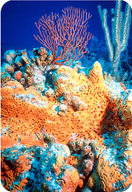11.4 海绵
Section outline
-
So what exactly is a sponge?
::那海绵到底是什么?Here we have a giant barrel sponge. How can something that looks like that be considered an ? Where's the head? Where are the legs? Where's the mouth?
::我们这里有一个巨大的桶状海绵。怎么可以把看上去像海绵的东西视为一个?头在哪里?腿在哪里?嘴在哪里?Sponges
::海绵Invertebrates are animals without a backbone . They are the most numerous animals on Earth. Most invertebrates are . However, simpler invertebrates evolved before insects. Some, like the sponges you will read about in this concept, have existed virtually unchanged for hundreds of millions of years. Their continued existence is evidence that they are well adapted for their habitats . They also evolved some of the most important traits that are found in almost all animals today. Without the traits that evolved in sponges and other simple invertebrates, you would not exist. Sponges are invertebrates that make up the phylum Porifera . The word "porifera" means pore-bearing. The phylum is aptly named. As you can see from Figure , a sponge has a porous body. There are at least 5,000 living of sponges. Almost all of them inhabit the ocean, living mainly on coral reefs or the ocean floor.
::无脊椎动物是没有脊椎的动物,它们是地球上数量最多的动物。 大部分无脊椎动物都是。 然而, 更简单的无脊椎动物是在昆虫之前进化的。 有些像您在这一概念中读到的海绵一样, 在数亿年的时间里几乎没有变化。 它们继续存在的证据是它们非常适合它们的栖息地。 它们也演化了今天几乎所有动物中发现的一些最重要的特征。 没有海绵和其他简单的无脊椎动物的进化特征, 你就不会存在。 海绵是构成植物浮质的无脊椎动物。 “ 浮质” 这个词是指孔状的。 浮质的名称很贴切。 从图中可以看出, 海绵有一个多孔的体。 至少有5000个海绵生活在海洋中, 主要是生活在珊瑚礁或洋底上。Sponge on a Coral Reef. This orange sponge is covered with pores. Can you predict the function of the pores?
::珊瑚礁上的海绵 橙色海绵被孔孔覆盖 你能预测这些孔的功能吗?Structure and Function of Sponges
::海绵的结构和功能Sponges come in a variety of shapes and sizes. For example, they may be shaped like tubes, fans, cones, or just blobs. They range in diameter from about a centimeter (0.4 inches) to over a meter (3.3 feet). Many species live in colonies that may be quite large. Adult sponges are sessile . This means they are unable to move from place to place. Root-like projections anchor them to solid surfaces such as rocks and reefs.
::海绵的形状和大小各异,例如,海绵的形状可能像管子、风扇、锥形或小球体,直径从大约1厘米(0.4英寸)到超过1米(3.3英尺)不等。许多物种生活在可能相当大的聚居区。成年海绵是粘性海绵,这意味着它们无法从一个地方移动。根状的投影将海绵固定在岩石和珊瑚礁等固体表面。Sponges have an internal skeleton that gives them support and protection. An internal skeleton is called an endoskeleton . A sponge endoskeleton consists of short, sharp rods called spicules (see Figure ). Spicules are made of silica, calcium carbonate, or spongin , a tough . They grow from specialized in the body of the sponge.
::海绵有支持和保护它们的内骨,内骨称为内骨骨骼。海绵内骨骼由短短的尖棒组成,称为光谱(见图 ) 。 光谱由硅、 碳酸钙或海绵组成, 坚硬。 它们从海绵体内专门生长而来。Sponge Anatomy. A sponge lacks tissues and organs, but it has several types of specialized cells.
::海绵解剖:海绵缺乏组织和器官,但有几种特殊细胞。Sponges are filter feeders . They pump into their body through their pores. The water flows through a large central cavity called the spongocoel (see Figure ). As the water flows by, specialized collar cells (which are also known as choanocytes) filter out food particles such as . Collar cells have tiny hairs that trap the particles. They also have a flagellum that whips the water and keeps it moving. Once the food is trapped, the collar cells digest it (see Figure ). Cells called amebocytes also help digest the food. They distribute the nutrients to the rest of the body as well. Finally, the water flows back out of the body through an opening called the osculum . As water flows through the sponge, oxygen diffuses from the water to the sponge’s cells. The cells also expel wastes into the water for removal through the osculum.
::海绵是过滤的饲料,它们通过孔洞抽进身体。水流通过一个称为松果球(见图 ) 的大型中央腔。 水流通过一个称为松果球(见图 ) 的大型中央腔。 当水流经过时, 专门的颈部细胞( 也称为细胞 ) 过滤食物颗粒, 比如 . 圆圈细胞有细小的毛毛可以捕捉这些颗粒。 它们还有一头旗杆, 鞭打水, 并保持水的移动。 一旦食物被困住, 领子细胞就会消化它(见图 ) 。 领子也叫做 细胞也会帮助消化食物。 它们把营养素分到身体的其他地方 。 最后, 水通过一个叫做的开口从身体流出。 当水流过海绵时, 氧从水流到海绵的细胞。 细胞还将废物排入水中, 以便通过流取。Collar Cell. The collar cells of sponges trap and digest food.
::海绵陷阱和消化食物的项圈细胞Sponge Reproduction
::海绵生殖Sponges reproduce both asexually and sexually. occurs by budding . Figure shows the sponge when is involved. Adult sponges produce eggs and . In many species, the same individuals produce both. However, they don’t produce eggs and sperm at the same time. As a result, self- is unlikely to occur. What is an advantage of avoiding self-fertilization?
::海绵的性生殖和性生殖都是由萌芽而成的。图中显示了海绵所涉及的时间。成年海绵产卵和。在许多物种中,同一批人同时产卵和精子。但是,他们不同时产卵和精子。结果,不可能出现自我。 避免自我受孕有什么好处呢?The sponge life cycle includes sexual reproduction. Sponges may also reproduce asexually.
::海绵的生命周期包括性繁殖,海绵也可能是性繁殖。Sperm are released into the surrounding water through the osculum. If they enter a female sponge through a pore, they may be trapped by collar cells. Trapped sperm are delivered to eggs inside the female body, where fertilization takes place. The resulting zygote develops into a larva . Unlike the adult, the larva is motile. It is covered with cilia that propel it through the water. As the larva grows, it becomes more similar to an adult sponge and loses its ability to swim.
::精液通过被释放到周围的水中,如果它们通过孔孔进入雌性海绵,就可能被锁住。被困的精子被送到雌性体内的卵中,在那里进行授精。由此形成的会发展成幼虫。与成年人不同的是,幼虫是motile。幼虫被粘住,通过水推进它。随着幼虫生长,幼虫与成年海绵更加相似,并失去游泳能力。Ecology of Sponges
::海绵生态学Sponges that live on coral reefs have symbiotic relationships with other reef species. They provide shelter for , shrimp, and crabs. In return, they get nutrients from the metabolism of the organisms they shelter. Sponges are a source of food for many species of . Because sponges are sessile, they cannot flee from predators . Their sharp spicules provide some defense. They also produce toxins that may poison predators that try to eat them.
::生活在珊瑚礁上的海绵与其他珊瑚礁物种有着共生关系,它们为虾类和螃蟹提供栖息地。反过来,它们从它们所保护的生物的新陈代谢中获得养分。海绵是许多种类的食品来源。海绵是食用海绵的食用来源。由于海绵很脆弱,它们无法逃离食肉动物。它们的尖锐光谱提供了一些防御。它们还产生毒素,可能毒害食食食食食的食肉动物。Summary
::摘要-
Sponges are aquatic invertebrates. They make up the phylum Porifera.
::海绵是水生无脊椎动物 它们组成了海豚 -
Sponges have specialized cells and an endoskeleton.
::海绵有专门的细胞和内骨骼。 -
Sponges lack tissues and body symmetry.
::海绵缺乏组织和身体对称。 -
Adult sponges are sessile filter feeders.
::成人海绵是西塞过滤器的饲料。 -
Sponge larvae have cilia for swimming.
::海绵幼虫有西里岛游泳
Review
::回顾-
Define sessile. Name an invertebrate with a sessile adult stage.
::定义 sessile 。 给无脊椎动物起个名字, 并给成年无脊椎动物起个名字 。 -
Describe the skeleton of a sponge.
::描述海绵的骨骼 -
Sponges have specialized cells called collar cells. Describe how collar cells are specialized for the functions they serve.
::海绵有专门的囚室,称为领子囚室,说明领子囚室如何专门从事其服务功能。 -
Create a diagram of an adult sponge body plan that shows how sponges obtain food.
::绘制成人海绵体体计划图,显示海绵如何获得食物。
-
Sponges are aquatic invertebrates. They make up the phylum Porifera.




